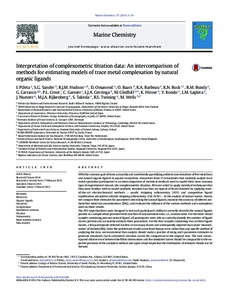| dc.contributor.author | Pižeta, I. | |
| dc.contributor.author | Sander, S.G. | |
| dc.contributor.author | Hudson, R.J.M. | |
| dc.contributor.author | Omanović, D. | |
| dc.contributor.author | Baars, O. | |
| dc.contributor.author | Barbeau, K.A | |
| dc.contributor.author | Buck, K.N. | |
| dc.contributor.author | Bundy, R.M. | |
| dc.contributor.author | Carrascog, G. | |
| dc.contributor.author | Croot, P.L. | |
| dc.contributor.author | Garnier, C. | |
| dc.contributor.author | Gerringa, L.J.A. | |
| dc.contributor.author | Gledhill, M. | |
| dc.contributor.author | Hirose, K. | |
| dc.contributor.author | Kondo, Y. | |
| dc.contributor.author | Laglera, L.M | |
| dc.contributor.author | Nuester, J. | |
| dc.contributor.author | Rijkenberg, M.J.A. | |
| dc.contributor.author | Takeda, S. | |
| dc.contributor.author | Twining, B.S. | |
| dc.contributor.author | Wells, M. | |
| dc.date.accessioned | 2019-01-08T00:32:59Z | |
| dc.date.available | 2019-01-08T00:32:59Z | |
| dc.date.issued | 2015 | |
| dc.identifier.citation | Pižeta, I.; Sander, S.G.; Hudson,, R.J.M.; Omanovi, D.; Baars, O.; Barbeau, K.A. et al (2015) Interpretation of complexometric titration data: An intercomparison of methods for estimating models of trace metal complexation by natural organic ligands. Marine Chemistry, 173, pp.3-24. DOI: https://doi.org/10.1016/j.marchem.2015.03.006 | en_US |
| dc.identifier.uri | http://hdl.handle.net/11329/635 | |
| dc.identifier.uri | http://dx.doi.org/10.25607/OBP-194 | |
| dc.description.abstract | With the common goal of more accurately and consistently quantifying ambient concentrationsof free metal ions
and natural organic ligands in aquatic ecosystems, researchers from 15 laboratories that routinely analyze trace
metal speciation participated in an intercomparison of statistical methods used to model their most common
type of experimental dataset, the complexometric titration. All were asked to apply statistical techniques that
they were familiar with to model synthetic titration data that are typical of those obtained by applying state-
of-the-art electrochemical methods–anodic stripping voltammetry (ASV) and competitive ligand
equilibration-adsorptive cathodic stripping voltammetry (CLE-ACSV)–to the analysis of natural waters. Herein,
we compare their estimates for parameters describing the natural ligands, examine the accuracy of inferred am-
bient free metal ion concentrations ([Mf]), and evaluate the influence of the various methods and assumptions
used on these results.
The ASV-type titrations were designed to test each participant's ability to correctly describe the natural ligands
present in a sample when provided with data free of measurement error, i.e., random noise. For the three virtual
samples containing just one natural ligand, all participants were able to correctly identify the number of ligand
classes present and accurately estimate their parameters. For the four samples containing two or three ligand
classes, a few participants detected too few or too many classes and consequently reported inaccurate 'measure-
ments’ of ambient [Mf]. Since the problematic results arose from human error rather than any specific method of
analyzing the data, we recommend that analysts should make a practice of using one's parameter estimates to
generate simulated (back-calculated) titration curves for comparison to the original data. The root–mean–squared relative error between the fitted observations and the simulated curves should be comparable to the expected precision of the analytical method and upon visual inspection the distribution of residuals should not be skewed. | en_US |
| dc.language.iso | en | en_US |
| dc.rights | Attribution-NonCommercial-NoDerivs 3.0 | * |
| dc.rights.uri | http://creativecommons.org/licenses/by-nc-nd/3.0/ | * |
| dc.subject.other | Complexation | en_US |
| dc.subject.other | Equilibrium constant | en_US |
| dc.subject.other | Metal ions | en_US |
| dc.subject.other | Organic ligands | en_US |
| dc.subject.other | Speciation | en_US |
| dc.subject.other | Titration | en_US |
| dc.subject.other | Voltammetry | en_US |
| dc.title | Interpretation of complexometric titration data: an intercomparison of methods for estimating models of trace metal complexation by natural organic ligands. | en_US |
| dc.type | Journal Contribution | en_US |
| dc.description.refereed | Refereed | en_US |
| dc.format.pagerange | pp.3-24 | en_US |
| dc.identifier.doi | https://doi.org/10.1016/j.marchem.2015.03.006 | |
| dc.subject.parameterDiscipline | Parameter Discipline::Chemical oceanography::Metal and metalloid concentrations | en_US |
| dc.subject.instrumentType | Multi-window titration | en_US |
| dc.subject.dmProcesses | Data Management Practices::Data analysis | en_US |
| dc.bibliographicCitation.title | Marine Chemistry | en_US |
| dc.bibliographicCitation.volume | 173 | en_US |
| dc.description.bptype | Best Practice | en_US |
| dc.description.bptype | Guide | en_US |
| obps.contact.contactemail | pizeta@irb.hr | |
| obps.resourceurl.publisher | https://www.sciencedirect.com/science/article/pii/S0304420315000596 | en_US |
 Repository of community practices in Ocean Research, Applications and Data/Information Management
Repository of community practices in Ocean Research, Applications and Data/Information Management

